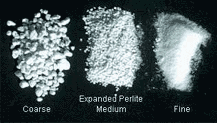





Origin and Characteristics...
Perlite is not a trade name but a generic term for naturally occurring
siliceous rock. The distinguishing feature which sets perlite apart from
other volcanic glasses is that when heated to a suitable point in its
softening range, it expands from four to twenty times its original volume.
This expansion is dues to the presence of two to six percent combined
water in the crude perlite rock. When quickly heated to above 871°C
(1600°F), the crude rock pops in a manner similar to popcorn as the
combined water vaporizes and creates countless tiny bubbles which account
for the amazing light weight and other exceptional physical properties
of expanded perlite.
This expansion process also creates one of perlite's most distinguishing
characteristics: its white color. While the crude rock may range from
transparent light gray to glossy black, the color of expanded perlite
ranges from snowy white to grayish white.
Expanded perlite can be manufactured to weigh as little as (32kg/m3) making
it adaptable for numerous applications in the construction, industrial,
chemical and horticultural.
Since perlite is a form of natural glass, it is classified as chemically
inert and has a pH of approximately 6.5 - 7.5.
|
CHEMICAL
COMPOSITION
|
|
|
72 - 76%
|
SiO2
|
|
11 - 17%
|
Al2O3
|
|
0.5 - 2%
|
CaO
|
|
0.1 - 0.5%
|
MgO
|
|
0.5 - 1.5%
|
Fe2O3 |
|
4 - 5%
|
K2O |
|
3 - 4%
|
Na2O
|
| Physical Properties | |
|
Color
|
White
|
|
Free moisture
|
0.5%
|
|
PH
|
neutral
|
|
Specific gravity
|
2.2 - 2.4
|
|
Bulk Density
|
70 - 120kg/m3
|
|
Softening Point
|
890 - 1100oC
|
|
Fusion Point
|
1280 - 1380oC
|
|
Specific Heat
|
0.2
|
Uses for Perlite...
There are many uses for perlite. These uses can be broken down into three
general categories: construction applications, horticultural applications,
and industrial applications.